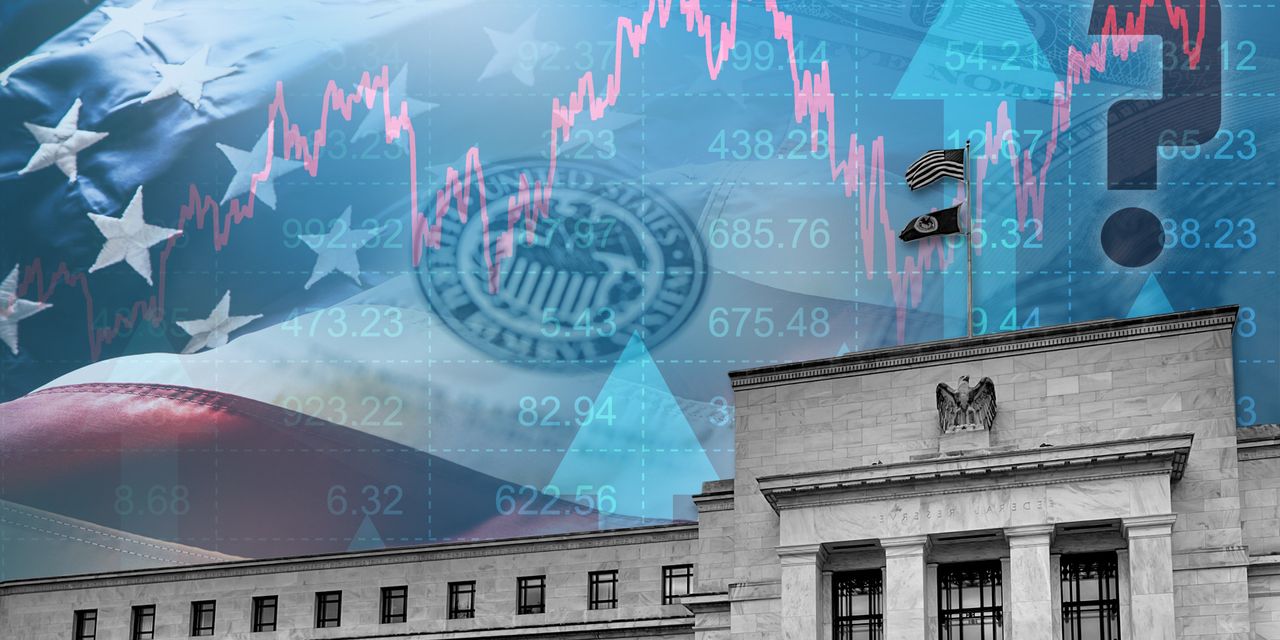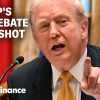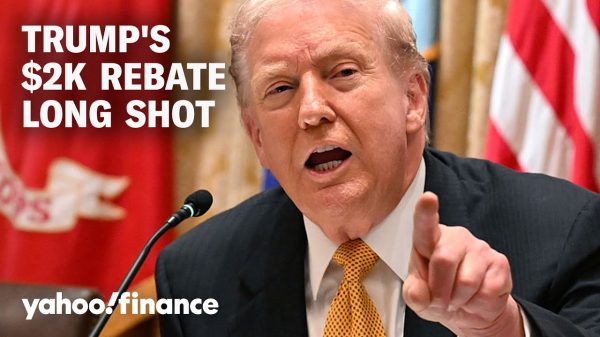The S&P 500 index just wrapped up its strongest first half of a year since 2019, as a U.S. recession feared near by many investors seems perpetually further away than anticipated, leaving the stock market rally’s momentum for the rest of 2023 in question.
It’s “difficult to gauge” when the “liquidity unleashed” by the U.S. government during the pandemic will run out, said José Torres, senior economist at Interactive Brokers, in a phone interview, referring to fiscal and monetary stimulus in 2020-2021. While the Federal Reserve has been raising interest rates since 2022 to battle high inflation, the Fed’s intervention after regional-bank failures in March provided more liquidity to the financial system, he said.
That “created this environment for risk assets to run higher,” said Torres. And then, the artificial-intelligence craze has more recently driven “momentum” in U.S. stocks, he said. “I think the market goes lower from here.”
The S&P 500
SPX,
in mid-March was trading near its starting level in 2023, as regional-bank woes weighed on stocks before the Fed’s intervention that month. The central bank’s bank term funding program, announced March 12, helped shore up confidence in the banking system, taking off “a lot of pressure on financial conditions,” according to Torres.
The S&P 500 rose 15.9% in the first six months of 2023 for its strongest first-half of a year since 2019, according to Dow Jones Market Data. Each of the index’s 11 sectors climbed in June, marking the first time since November that all of them were up in the same month.
The U.S. economy has been resilient despite the Fed’s rapid interest rate hikes in 2022 to cool demand and bring down still high inflation. Investors appear to be shrugging off recession worries after some surprisingly strong economic data in recent days.
“Ladies and Gentleman, the recession has been cancelled!” wrote Bernard Baumohl, chief global economist at the Economic Outlook Group, in a note emailed June 29.
“Let’s not forget that despite the economy’s impressive performance the first three months, prices have continued to ease as well,” Baumohl said in the note. “Virtually every inflation metric has been falling,” he said, so “unless inflation shows signs of reversing course and accelerates, the Fed should maintain its current pause.”
The Fed has slowed its interest-rate hikes this year, pausing them at its June policy meeting while signaling that further rate increases may still be coming. Federal-funds futures on Friday showed traders largely expecting the Fed to lift its benchmark rate by a quarter point in July to a targeted range of 5.25% to 5.5%, according to the CME FedWatch Tool, at last check.
Investors have cheered the Fed’s pause, with many expecting it’s near the end of its rate-hiking cycle, which had led to brutal losses for stocks and bonds last year.
Meanwhile, economic data released in the past week showed a revised estimate for U.S. growth in the first quarter was higher than anticipated; new orders for manufactured durable goods were stronger than expected in May; sales of newly built homes that same month beat economists’ forecasts; consumer confidence jumped in June to a 17-month high based on a Conference Board survey; and that initial jobless claims in the week ending June 24 fell.
See also: U.S. economy on track to grow as fast as 2% in the second quarter
Investors also welcomed more evidence of inflation easing. U.S. inflation measured by the personal-consumption-expenditures price index softened to 3.8% in May on a 12-month basis, the slowest increase since April 2021, based on a government report Friday.
But Torres said he worries the U.S. economy may be growing too fast for the Fed’s fight with inflation, potentially leading the central bank to become more hawkish by further tightening monetary policy.
‘Shocked’
“There’s a huge discrepancy” between two-year Treasury yields
TMUBMUSD02Y,
and where the Fed has indicated its benchmark rate may wind up at the end of its hiking cycle, he said. That’s after the recent rise in two-year yields from the wake of their fall during the regional-banking stress.
The Fed’s summary of economic projections, released in June, showed its policy rate could wind up as high as 5.6% by the end of this year, compared to a current targeted range of 5% to 5.25%.
Meanwhile, the yield on the two-year Treasury note rose 81.7 basis points in the second quarter to 4.877% on Friday, the highest level since March 9 based on 3 p.m. Eastern Time levels, according to Dow Jones Market Data.
“I’ve been shocked the market has already been able to digest this yield move to the upside,” said Torres. “There’s still more room to the upside on yields,” he said, adding that two-year Treasury rates often are viewed as a gauge of how hawkish the Fed may be with its policy rate.
The U.S. stock market rose on Friday, closing out June with weekly, monthly and quarterly gains.
The S&P 500 and Nasdaq Composite
COMP,
each finished the month at its highest closing level since April 2022, with both indexes notching their longest monthly win streaks since 2021, according to Dow Jones Market Data. The technology-heavy Nasdaq soared 31.7% during the first six months of 2023, clinching its best first half since 1983.
Sentiment in the stock market has gotten “pretty frothy,” making equities vulnerable to a decline, said Liz Ann Sonders, chief investment strategist at Charles Schwab, in a phone interview. “On the surface the market has been incredibly resilient, but of course the concentration has been extreme.”
She pointed to a “small handful” of megacap stocks, including names like Apple Inc.
AAPL,
Microsoft Corp.
MSFT,
and Nvidia Corp.
NVDA,
powering the performance of the S&P 500 and Nasdaq.
Read: Apple clinches $3 trillion valuation, becoming first U.S. company to close at that mark
Such stocks “really kicked into high gear” at the start of the banking trouble in March, as investors, in a defensive move, sought companies that are “highly liquid” and generate cash, she said.
Stocks in that megacap group, sometimes referred to as Big Tech although they span sectors including communication services and consumer discretionary as well as information technology, have also benefited from AI exposure, said Sonders.
Weakness, strength on the roll
Sonders said she sees the U.S. as having experienced “rolling” recessions in different segments – such as housing or manufacturing – as opposed to the entire economy being swept up in a full-blown downturn. “The recession versus no recession debate” is missing the current nuances of this cycle, in her view.
“We’ve seen weakness and strength rolling through the economy as opposed to everything either booming at the same time, or falling apart at the same time,” she said. So while cracks may turn up in the services sector, the U.S. could still benefit from other areas, such as the recent lift seen in the housing market, which already has gone through a recession, according to Sonders.
Read: Homebuilder ETF outperforms S&P 500, industry’s stocks still ‘cheap’ in 2023 market rally
In the stock market, megacap names have gotten a lot of attention for their surge this year, yet other pockets, such as homebuilders and the S&P 500’s industrials sector, have recently done well, she said. Industrial stocks
SP500EW.20,
recently stood out to Sonders for their “decent breadth.”
But to her thinking, “this is not the kind of environment to make a monolithic sector call or two,” rather Sonders favors screening stocks for characteristics such as “high quality” when looking for investment opportunities.
Fluctuating financial conditions have made it harder to discern when the U.S. could fall into a recession, according to Torres. But rates rising further poses the risk of returning to the kind of environment that created stress for regional banks, he said. And with “commercial real estate lurking in the background” as a concern, he said it’s tough to see the stock market climbing from the S&P 500’s already “rich” levels.
“The higher the Fed pushes rates, the more pressure that’s gonna put on bank balance sheets,” said Charlie Ripley, senior investment strategist for Allianz Investment Management, in a phone interview. “It just becomes a question of whether or not you’re going to see a run on a particular bank.”
This coming week, the Fed will release minutes from its June policy meeting. Investors will see them on Wednesday, the day after the July 4 holiday in the U.S.
While the S&P 500 has rallied in 2023, shares of the SPDR S&P Regional Banking ETF
KRE,
sank 30.5% in the first half of the year while the Invesco KBW Bank ETF
KBWB,
is down 20.5% over the same period, according to FactSet data.
“There is a lot of dispersion within the market,” said Ripley. “There are pockets that are doing better than others.”
Read the full article here









